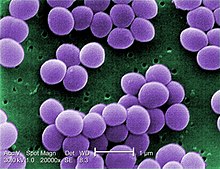Staphylococcaceae
| Staphylococcaceae | |
|---|---|
 | |
| Staphylococcus aureus | |
| Scientific classification | |
| Domain: | Bacteria |
| Phylum: | Bacillota |
| Class: | Bacilli |
| Order: | Bacillales |
| Family: | Staphylococcaceae Schleifer and Bell 2010[1] |
| Genera[2] | |
| Abyssicoccus | |
The Staphylococcaceae are a family of Gram-positive bacteria that includes the genus Staphylococcus, noted for encompassing several medically significant pathogens.
The five genera Jeotgalicoccus, Macrococcus, Nosocomiicoccus, Salinicoccus, and Staphylococcus have been shown to be monophyletic, while Gemella appears to be polyphyletic. The pathogen methicillin-resistant Staphylococcus aureus is a member of this family.
The most famous species in this family is Staphylococcus aureus, usually found in the skin microbiota. Staphylococcus aureus is the pathogenic bacteria with the highest global mortality in 2019, with approximatively 1.1 million deaths.[3]
References
- ^ Parte, A.C. "Staphylococcaceae". LPSN. Retrieved 4 March 2018.
- ^ "Classification of prokaryotes - Family Staphylococcaceae". LPSN. Retrieved 4 March 2018.
- ^ GBD 2019 Antimicrobial Resistance Collaborators (2022). "Global mortality associated with 33 bacterial pathogens in 2019: a systematic analysis for the Global Burden of Disease Study 2019". The Lancet. 400 (10369): 2221–2248. doi:10.1016/s0140-6736(22)02185-7. ISSN 0140-6736. PMC 9763654. PMID 36423648. Retrieved 19 August 2024.
- v
- t
- e











